You'll find distinct dilution ratios across the fragrance wheel, with each scent family requiring specific concentrations. Fresh and citrus notes need 15-20%, florals perform best at 12-18%, oriental scents demand 20-25%, and woody notes balance at 18-22%. Start with these standard ranges, then adjust based on your specific ingredients and desired strength. Understanding these fundamental ratios will release your ability to create perfectly balanced fragrances.
Understanding Fragrance Wheel Dilution Basics
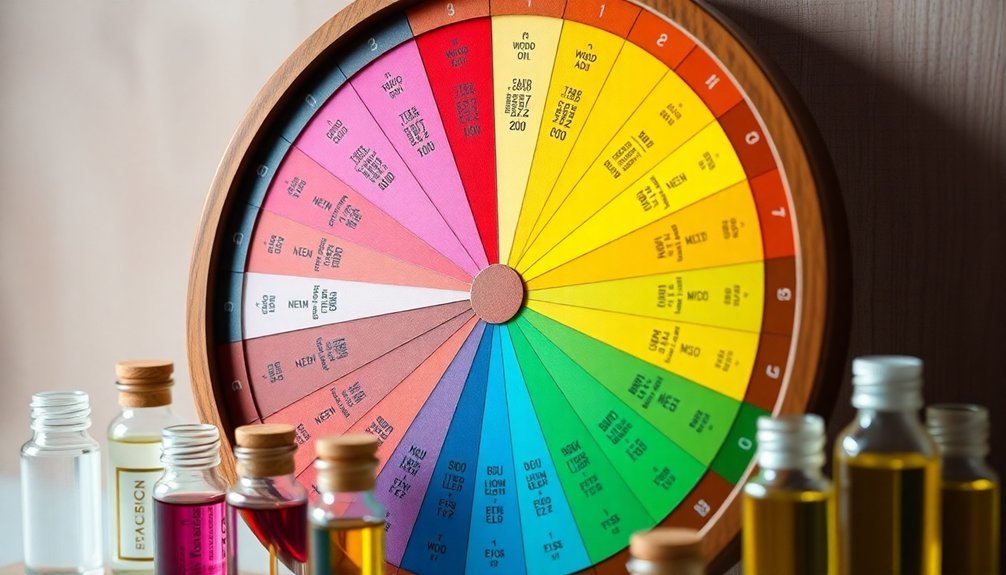
When crafting fragrances, understanding the dilution chart's fundamentals can make the difference between a perfectly balanced scent and an overpowering one.
The fragrance wheel serves as your essential guide, helping you determine the ideal concentration for different fragrance families.
You'll find that dilution ratios typically range from 1% to 30%, depending on your desired outcome.
When you're working with essential oils and aromatic compounds, the dilution chart helps you achieve consistent results across various applications, from personal perfumes to commercial products.
You'll need to carefully consider how different fragrance notes interact as you're blending them with carriers like alcohol or oil.
Essential Dilution Ratios for Floral Notes
When you're working with floral notes in perfumery, you'll need to maintain precise dilution ratios between 10% and 30% to achieve ideal fragrance balance.
You'll find that delicate flowers like rose and jasmine perform best at lower concentrations around 15%, while bolder blooms such as tuberose require up to 25% dilution to make their presence known.
To create successful floral blends, record your exact measurements and remember that roses particularly shine when paired with complementary scents at carefully controlled ratios.
Floral Dilution Best Practices
Creating the perfect floral fragrance requires precise dilution ratios to maintain the delicate balance of scent profiles. You'll want to dilute floral notes between 10-20% in your perfume compositions, while being extra careful with potent essential oils like rose and jasmine, which need a 5-15% dilution ratio.
| Floral Component | Recommended Dilution |
|---|---|
| Light Florals | 15-25% |
| Potent Essential Oils | 5-15% |
| Overall Floral Blend | 30% of composition |
| Fixatives | 1-5% |
When you're blending different scent families, keep your floral components at 30% of the total fragrance to achieve proper harmony. Don't forget to incorporate fixatives like sandalwood or vetiver at 1-5% dilution to enhance and stabilize your floral notes without overwhelming the composition.
Creating Balanced Rose Ratios
Building on our floral dilution guidelines, rose essential oil demands particular attention in perfume compositions.
You'll want to maintain a dilution ratio between 10% and 30% to achieve the perfect strength in your fragrance formulations.
To create a balanced rose fragrance, you'll need to take into account complementary floral notes. A proven formula combines 50% rose with equal parts jasmine and peony (25% each), resulting in a rich scent profile that's both complex and harmonious.
Don't forget to factor in evaporation rates – you might need to increase the concentration of top notes to guarantee lasting power.
Always dilute your rose essential oil with a carrier oil or alcohol to preserve its delicate characteristics.
This step isn't just about preservation; it's vital for maintaining the integrity of your perfume while enabling versatile applications.
Jasmine Concentration Guide
Jasmine's versatile dilution ratios serve as a cornerstone in modern perfumery, with concentrations ranging from 5% to 20% in standard formulations.
You'll find that jasmine's sweet, exotic aroma works beautifully as a heart note, creating harmonious blends with both lighter and deeper fragrances.
When working with jasmine absolute, you can achieve different effects by adjusting your dilution ratios from 1:20 for subtle touches to 1:5 for more intense expressions.
- Light floral blends: Use 5% concentration for delicate, morning-fresh scents
- Medium intensity: Aim for 10% concentration in balanced daily wear fragrances
- Bold presence: Apply 15% concentration for evening perfumes
- Luxurious impact: Reserve 20% concentration for opulent special occasion scents
As a perfumer, you'll master these concentrations to craft signature fragrances that capture jasmine's full aromatic potential.
Amber and Oriental Scent Concentration Guidelines
When developing Amber and Oriental fragrances, you'll need higher concentrations of essential oils than most other scent families, typically between 20% and 30%.
These rich scents require careful attention to the balance between top notes, heart notes, and base notes, with particular emphasis on the latter for lasting power.
Your base notes will need heavier fixatives like benzoin and labdanum to anchor the fragrance, while incorporating classic Oriental elements such as vanilla, myrrh, and spices.
When working with these concentrated oils, you'll want to follow standard dilution ratios of 1:3 or 1:4 with a carrier like ethanol.
As a perfumer, you'll find that these higher concentrations help create the opulent, warm profiles that amber and Oriental fragrances are known for, ensuring they maintain their distinctive character throughout wear.
Woody Notes Dilution Standards and Ratios
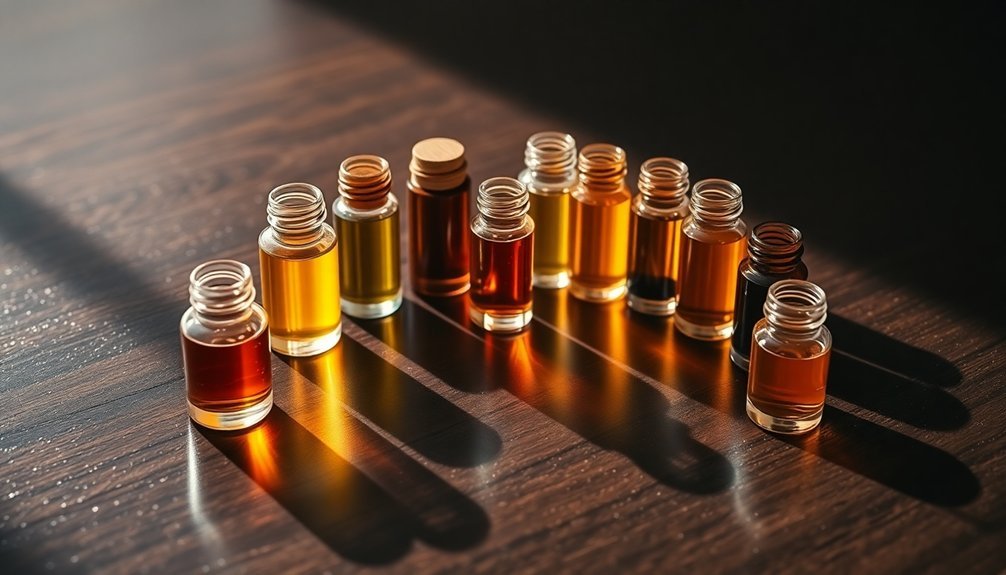
Unlike more delicate scent families, woody notes require precise dilution ratios to achieve their signature depth and character.
When you're working with the fragrance wheel, you'll find that woody notes typically perform best at 10-30% concentration in your final blend. For a harmonious fragrance blend, you'll want to carefully balance these aromatic components with floral notes and fresh notes.
- Sandalwood and cedarwood need different dilution standards based on their unique volatility profiles
- You'll need lower concentrations for spray formulations versus concentrated perfume oils
- Always conduct stability tests to guarantee your woody notes don't overwhelm other scent elements
- The perfume industry standard suggests blending woody notes with lighter accords at carefully measured ratios
Fresh and Citrus Notes Blending Proportions
Because fresh and citrus notes evaporate rapidly, you'll need to carefully balance their proportions in your fragrance compositions.
When creating uplifting fragrances, aim for 20-30% citrus notes to maintain their vibrant character while allowing complementing notes to shine through. To enhance longevity, you'll want to anchor these volatile elements with sturdy base notes like woods or musks.
For a harmonious blend, incorporate 10-15% floral components or herbal accents alongside your fresh notes. This combination creates a well-rounded scent that's both complex and balanced.
Remember that temperature influence plays an essential role in how these notes perform – they're typically more pronounced in warm conditions, making them ideal for summer fragrances. Adjust your blending proportions accordingly when designing seasonal perfumes to achieve ideal results.
Base Note Dilution Measurements and Charts

To create successful base note dilutions, you'll need to follow precise ratios typically ranging from 10% to 30% concentration, depending on your fragrance's intended strength.
Your base note measurements must account for solvent compatibility, ensuring ingredients like sandalwood and vanilla blend seamlessly with your chosen carrier.
Using the fragrance wheel as your guide, you can determine which base note concentrations work best within specific fragrance families, allowing you to achieve the perfect balance for your formula.
Precise Base Note Ratios
Base notes serve as the essential anchor in perfumery, requiring precise dilution ratios to achieve the perfect foundation for lasting fragrances.
When you're creating signature scents, you'll need to maintain base note concentrations between 20% to 30% of your total fragrance formulation. For ideal blending and scent strength, dilute essential oils like sandalwood and patchouli with carrier oils using ratios of 1:3 or 1:4.
- Start with a balanced fragrance composition by following established dilution charts
- Measure your base notes precisely to guarantee proper depth and longevity
- Mix heavier scents like woods, resins, and musks in carefully controlled proportions
- Consider how your base notes will interact with heart and top notes for a harmonious blend
These precise measurements will help you craft well-rounded perfumes that maintain their character throughout wear.
Solvent Compatibility Standards
When selecting solvents for your fragrance formulations, you'll need to follow strict compatibility standards that secure proper dilution and stability of base notes.
Your base note dilution should range from 5% to 30%, depending on your desired longevity and overall fragrance profile.
Consider using common solvents like ethanol, isopropyl myristate, or carrier oils, as each affects how your fragrance materials diffuse and perform.
You'll want to verify the solubility of your ingredients with your chosen solvent to prevent unwanted reactions that could alter your final scent.
Remember to align your dilution ratios with IFRA regulations to confirm your fragrance ingredients remain safe for consumer use.
Check your solvent compatibility standards carefully, as they're essential for achieving the perfect blend and maintaining the integrity of your fragrance formulation throughout its lifecycle.
Achieving Balance Through Strategic Dilutions
Creating balanced fragrances demands a masterful understanding of dilution ratios, which serve as the foundation for harmonious scent compositions.
When you're working with strategic dilutions, you'll need to take into account how different scent families interact on the fragrance wheel. The dilution process directly affects the volatility and solubility of your essential oils, ultimately impacting how your complex fragrances perform.
- You'll want to maintain concentrations between 10-30% for ideal balance
- Think about using the aroma wheel to guide your dilution decisions
- Monitor how each scent family performs at different dilution levels
- Test evaporation rates to guarantee your fragrance maintains its intended character
Mastering Scent Strength Across Fragrance Families
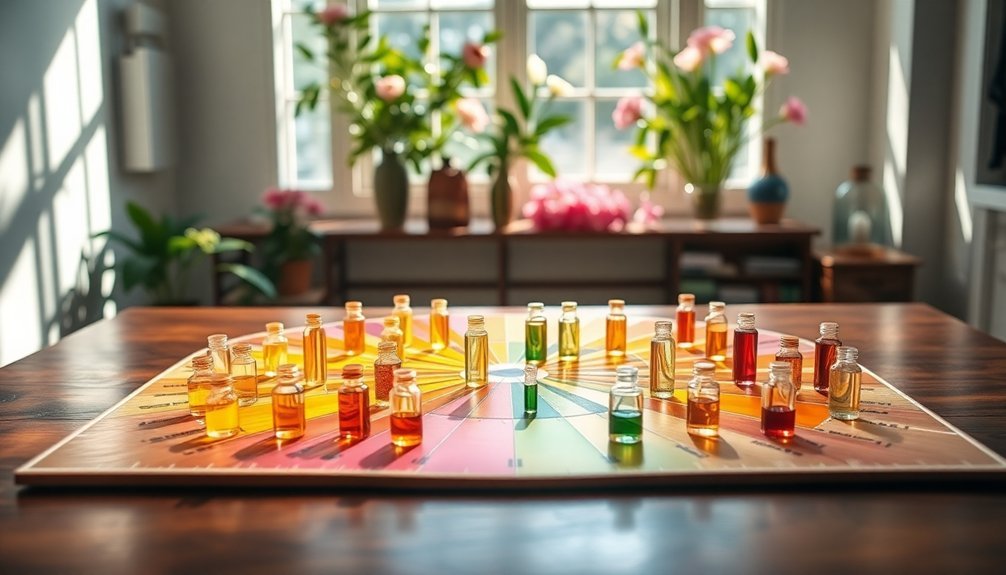
Understanding the nuanced strength variations across fragrance families forms the cornerstone of successful perfume formulation. As you work with the fragrance wheel, you'll notice how each family demands specific dilution ratios to achieve ideal scent strength.
| Scent Family | Recommended Dilution Range |
|---|---|
| Fresh | 15-20% for citrus notes |
| Floral | 12-18% for balanced bloom |
| Oriental | 20-25% for rich depth |
| Woody | 18-22% for warm base |
When you're crafting perfumes, you'll need to adjust these ratios based on your base notes' intensity. Fresh fragrances often require higher dilution to prevent overwhelming top notes, while oriental and woody scents can handle stronger concentrations. Remember that perfumers must consider how these families interact when creating complex blends, as each component influences the overall scent strength differently.
Frequently Asked Questions
What Is the 20/50/30 Rule for Perfume?
You'll create balanced perfumes by using 20% top notes for initial impact, 50% heart notes for main character, and 30% base notes for lasting depth. It's a proven formula for well-structured fragrances.
What Is the Dilution Ratio for Perfume?
You'll typically use 10-30% fragrance oil for eau de parfum and 5-15% for eau de toilette. For solid perfumes, stick to 20% fragrance oil with 80% carrier base for ideal scent performance.
What Is 20 to 40 Concentration Perfume?
You'll find that 20 to 40 concentration perfume is typically an Eau de Parfum, containing 15-20% fragrance oils. It'll give you a strong, long-lasting scent that stays on your skin for 4-8 hours.
What Is the Best Dilution for Perfume?
For the best perfume dilution, you'll want to aim for 15-30% fragrance concentration if you're making eau de parfum. If you prefer lighter scents, consider 5-15% for eau de toilette formulations.
In Summary
You're now equipped to create perfectly balanced fragrances using professional dilution ratios. By following these wheel-based guidelines, you'll master the art of blending across all scent families – from delicate florals to robust orientals. Remember to test your dilutions methodically and keep detailed notes of successful formulas. Don't hesitate to adjust percentages within the recommended ranges until you've achieved your desired scent profile.
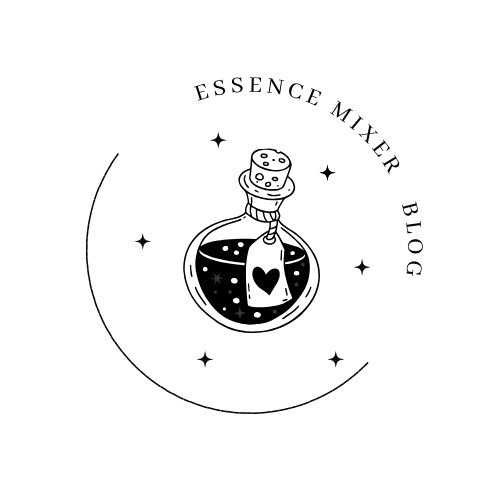
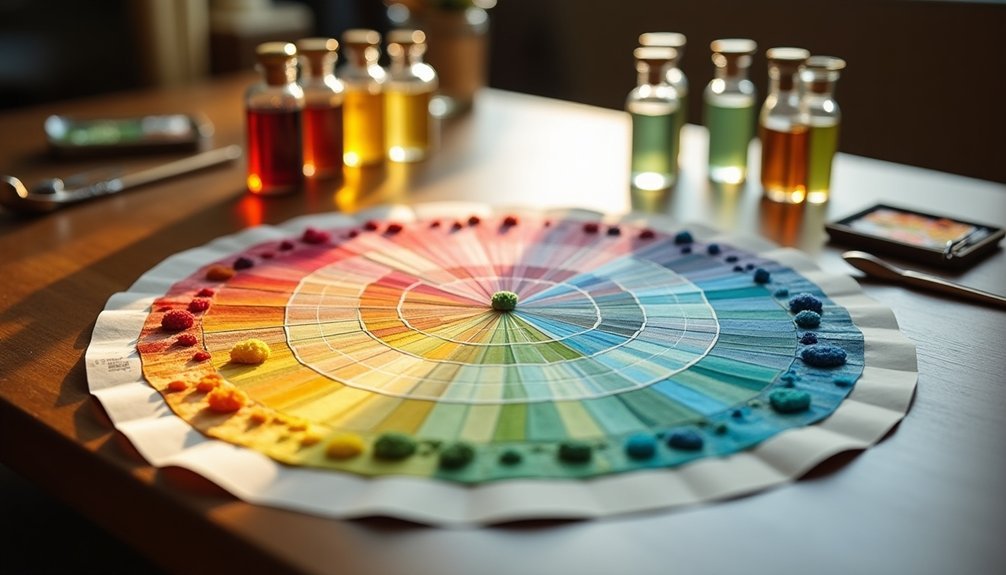



Leave a Reply